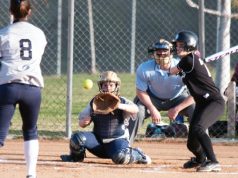Everyone wants to be known as a good plate umpire. When coaches think about preferred and non-preferred lists of umpires for postseason playoffs, they think about your performance as a plate umpire.
Effective use of the six steps of calling a pitch will dramatically improve your accuracy behind the plate:
1. On the rubber.
Watch the pitcher while standing comfortably behind the plate in a relaxed, upright position, in the slot, between the batter and the catcher. Be alert for when the pitcher steps on the pitcher’s plate and prepare for the pitcher to begin her motion.
2. Get set.
Drop to a balanced and comfortable set position as the pitcher starts her motion. For the popular heel-toe-heel-toe stance, use a base that’s wider than shoulder width apart, with an imaginary line drawn from the heel of the catcher’s inside foot, to the toe of the umpire’s slot foot. A second imaginary line can be drawn, from the heel of the umpire’s slot foot, to the toe of the back foot that’s behind the catcher.
The umpire’s ear that’s nearest home plate should be lined up with the black on the inside corner. The slot foot is pointed directly at the pitcher and the back foot is angled 45 degrees away from the catcher to provide the necessary clearance between the catcher and the umpire. The umpire’s chin should never drop below the top of the catcher’s helmet as the umpire bends at the knees rather than the waist. An upside down “V” should form at the umpire’s crotch with 80 percent of the body weight forward. The umpire’s buttocks should never drop below his or her knees. The umpire should hold his or her hands in relaxed fists or lock the hand nearest home plate on the upper back of the hamstring muscle.
Develop a personal locking mechanism to prevent you from dropping too low in your set as the game progresses. If necessary, ask your base umpire(s) to monitor your head position throughout the game.
3. Track.
Try to pick up the ball as it comes out of the pitcher’s hip area. The sooner you see the ball the better. Track the pitch with both eyes and your head motionless as the ball heads to the plate. Plan to track the ball with your eyes all the way into the catcher’s glove. It is imperative you avoid tunnel vision. Tunnel vision means an umpire is looking down the tunnel to the pitcher’s release point and not tracking the ball to its destination. To avoid dreaded blinking behind the plate, lean slightly into each pitch as if you are going to catch the ball with your eyes.
4. Read.
Reading the pitch means analyzing the pitch as it nears the plate. Remember that you are now an umpire and no longer a player. Batters must read the pitch well in front of the plate to have time to start their swing when the ball arrives. An umpire must not read a pitch too soon, as a batter would do, and cannot make a final read until the ball smacks into the catcher’s glove. Consider each pitch a strike until it proves itself a ball.
5. Hold.
The hold mode is vitally important. Don’t be in a hurry to rise from your set position stance as you see the pitch. While some umpires painfully hold their calls to the point of frustration, a vast majority of amateur umpires call pitches too quickly. At the end of your hold position, determine the final status of the pitch.
6. Call it.
The calling phase is different from the hold and should not be combined. Develop a consistent method of announcing the status of each pitch. Call balls from the down position. Strikes may be called from either the down or upright positions but choose a method of announcing strikes and be consistent. It’s best to signal strikes from an upright position. Many top umpires use a third-strike signal that’s different from their strike one and strike two signals. That way a coach cannot misconstrue your third-strike signal with an out signal.
Philosophy.
Visualize your strike zone one last time as you brush the plate before the start of the game. Clean any dirt off the black border of the plate and bevel the dirt three inches on each side of the plate. That makes the plate appear wider.
Can you call one pitch correctly? If so, continue to call each pitch as the one and only pitch of the game. Establish your game early by not missing any strikes. Expecting to call every pitch correctly may not be realistic but vow never to miss strikes.
What's Your Call? Leave a Comment:
Note: This article is archival in nature. Rules, interpretations, mechanics, philosophies and other information may or may not be correct for the current year.
This article is the copyright of ©Referee Enterprises, Inc., and may not be republished in whole or in part online, in print or in any capacity without expressed written permission from Referee. The article is made available for educational use by individuals.


















